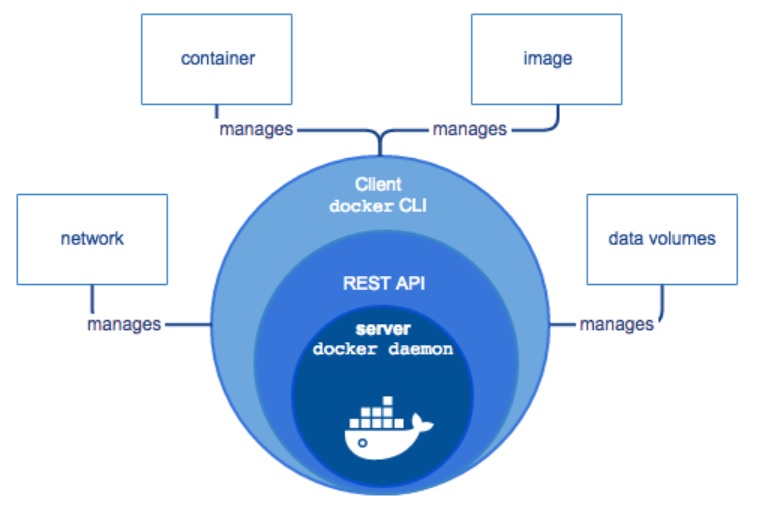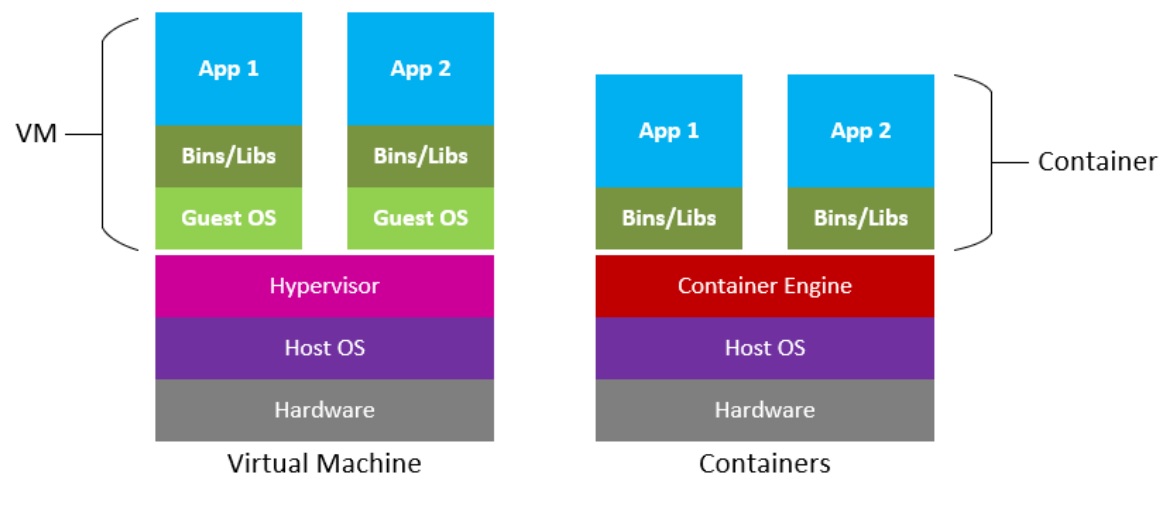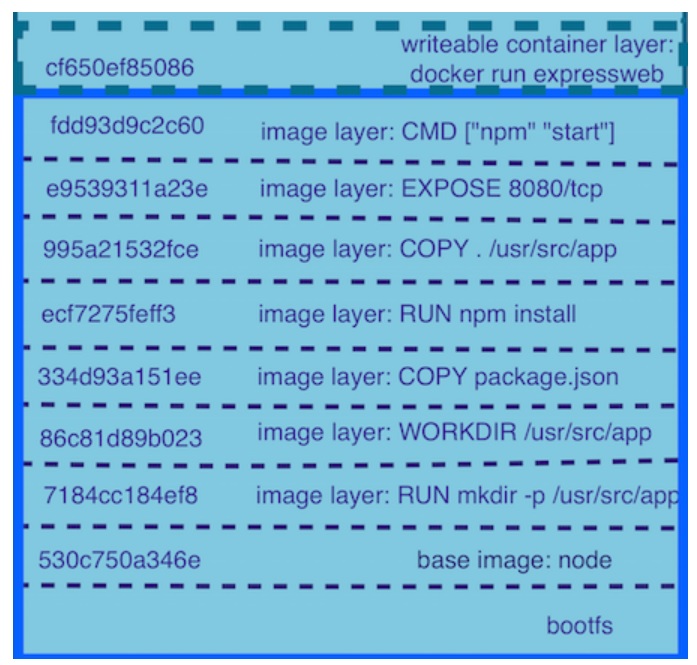This is a quick and dirty Docker, Docker-Machine and Docker Swarm cheatsheet, this is still being worked on.
First lets start with some Docker terminology, below are the commonly used parts of the Docker Platform
| Docker Server | is a server with Docker installed and has images and containers (running), its where the Docker Engine (see below) is running. |
| Docker Client | is the primary way that many Docker users interact with Docker |
| Docker Machine | Docker Machine allows you to provision Docker machines in a variety of environments, including virtual machines that reside on your local system, on cloud providers, or on bare metal servers (physical computers) |
| Docker Compose | is a tool for defining and running multi-container Docker applications. With Compose, you use a YAML file to configure your application’s services. Then, with a single command, you create and start all the services from your configuration. |
| Docker Hub | is the world's easiest way to create, manage, and deliver your teams' container applications |
| Docker Image | single file with all the dependencies and configuration required to run a specific program (for example Redis, JBoss, etc). The image will also contain a startup command to start what ever service you need to be running. |
| Docker Container | is a instance of an image, its like a running program that offers a service (for example Redis, JBoss, etc), a container has its own memory, own networking, etc basically it's isolated from other containers. You can create, start, stop, move, or delete a container using the Docker API or CLI. You can connect a container to one or more networks, attach storage to it, etc. Think of a container as a set processes that has access to a group of reources specify assigned to it. |
| Docker Engine | is a client-server application with these major components
|
The Docker Platform can be seen in the below image

The below diagram displays the difference between a virtual machine (VMware) and a Docker container, the big difference is that the running containers share the host OS kernel, virtual machines use a guest O/S.

Below are some of the commonly used docker and docker-compose commands
| Docker and docker-compose installation | yum install docker-engine # Docker-Compose installation yum install epel-release yum install -y python-pip pip install docker-compose yum upgrade python* # update python pip install backports.ssl_match_hostname --upgrade # if get hostname mismatch error you can use either container ID or container name |
| Directories | /var/lib/docker # Docker directory /var/lib/docker/containers |
| General commands | docker version # get both client and server versions docker info # get the server docker detailed information docker login --username=datadiskpfv --email=paul.valle@datadisk.co.uk # login into docker hub docker logout # logout of docker hub docker events # print out realtime docker server events, you have filter start/end times docker system prune [-a] # delete all stopped containers, unused networks, dangling images and build cache |
| Images | docker search <search_string> # search for images on docker.io docker images # list all images docker rmi [-f] <image> # remove an image docker history [--no-trunc] <image> # display the history (layers) of an image docker inspect <image> # inspect an images, get lots of detail docker tag <image:tag> <image:tag> # associates a repo and a tag name with an image docker [save|load] [-o|-i] # save/loads an images to/from a tar file, (-o = output) (-i = input) docker commit -c 'CMD ["<command>"]' <container ID> test/cowsayimage:latest # keep a running image and specify a startup command docker push <image> # when pushing images make sure you are logged in (see general commands) docker pull <image> # when pulling images make sure you are logged in (see general commands) |
| Volumes | docker volume create # create a docker volume docker volume ls # list all docker volumes docker volume rm <volume name> # remove a docker volume docker volume inspect <volume name> # inspect a docker volume |
| Containers | docker ps [-a] [--no-trunc] # list the containers (-a will list all stopped containers)
docker stop <container ID> # stop a running container gracefully if possible, otherwise a kill will be sent after 10 seconds
docker kill <container ID> # stop a running container in its tracks
docker start [-i|-a] <container ID> # start an existing container (use docker ps -a to list all)
docker rm <container ID> # remove a container (make sure its stopped first)
docker rm -v $(docker ps -aq -f status=exited) # remove all exited containers
docker rm $(docker ps -aq) # another version of above
docker top <container ID> # TOP process command for a container
docker export/import # export/import an images to a tar file (no layer history, port CMD, endpoints, etc)
docker create <image> # create a container using a image
docker rename <container ID> <new name> # rename a container
docker inspect <container ID> # get container information (get IP address for example)
docker inspect --format '{{.NetworkSettings.IPAddress}}' <container ID> # get specific container information
docker inspect -f '{{.Mounts}}' <container ID> # another example this time looking at Mounts
docker diff <container ID> # see if any changes to the container has happened
docker logs <container ID> [-f] # list what has happened inside container, -f like tail
docker exec -it <container ID> bash # connect to a running container, must have image id and bash at end
docker exec -it --user <user> <container ID> sh # connect to a running container as a specific user, also using shell this time
docker attach <container ID> # connect to a running container, when disconnect stops container (use ctrl-P and then Ctrl-Q to ext with stopping)
docker port <container ID> # display any ports that are used by the container |
| Run commands | docker run -i -t debian /bin/bash # run a container (image debian) but give us a shell inside container (-t = tag/image, -i interactive shell) docker run test/cowsay-dockerfile # start the container (will create a separate container for each run) docker run --rm -it --link myredis:redis redis /bin/bash # start a container and link it to the myredis container docker run -it --name container-test -h CONTAINER -v /docker/cowsay/data:/data debian /bin/bash # the v means mount /data in the container to the external /home/pvalle/data docker run -it -h NEWCONTAINER --volumes-from container-test debian /bin/bash # mount the above /data in a new container, now they share docker run --rm --volumes-from dbdata -v $(pwd):/backup debian tar cvf /backup/backup.tar /var/lib/postgresql/data # backup a containers postgresql /data area docker run -d -p 8000:80 nginx # start a container bind a local port 8000 to the container port 80 docker run -d -P nginx # same as above but docker will select a free server port to connect to container port 80 docker run -p 8080:8080 -p 9990:9990 -p 9999:9999 -it jboss # run a jboss contain and assign ports |
A Dockerfile is a text document that contains all the commands a user could call on the command line to assemble an image. below are some (but not all) of the commonly used instructions, a dockerfile must start with the FROM instruction
- FROM - This will set the base image using the parent image you have specified, examples are hello-word, ubuntu,
- COPY - add files or directories to the image, this is more simple than ADD
- ADD - add files or directories to the image, has more features than COPY
- ENV - used to define environment variables
- RUN - will execute commands, useful if you want to update the OS image for example, or create a user, etc
- VOLUME - tell Docker to store specific files in a specific directory that should be stored on the host file system not in the containers file system
- USER - from this point forward run as a specific user
- WORKDIR - define a working directory, handy if you need to copy files to a specific place
- EXPOSE - inform your users about the ports your application is listening on for example port 80 for a HTTP connection.
- CMD - is the instruction to specify what component is to be run by your image with arguments
- ENTRYPOINT - helps you to configure a container that you can run as an executable
| Docker build commands | docker build . # Will use Dockfile in current directory docker build -f Dockerfile.dev . # use the -f to specify the name of the docker file # tag name convention is <your Docker ID>/<repo or project name>:<version> docker build -t test/cowsay-dockerfile:latest . # build a image (the . means use a Dockerfile, -t tag name) Note: the default name of a docker file is Dockerfile |
| Docker file example | FROM node:alpine # change to /app directory in container WORKDIR '/app' # copy from filesytem to container COPY ./package.json ./ # run the command npm install inside the container RUN npm install # copy from filesytem to container COPY . . # run the command "npm run start" inside the container CMD ["npm", "run", "start"] |
| Docker file example | # build image for JBoss EAP 7.1 # Use parent image eap71-openshift FROM registry.access.redhat.com/jboss-eap-7/eap71-openshift # file author / maintainer MAINTAINER "FirstName LastName" "emailaddress@gmail.com" # Deploy your application by copying war file to deployments folder COPY app.war $JBOSS_HOME/standalone/deployments/ # User root to modify war owners and create volume USER root # Modify owners war RUN chown jboss:jboss $JBOSS_HOME/standalone/deployments/app.war # Specify a external volume to keep the log files VOLUME /opt/jboss/wildfly/standalone/log # Important, use jboss user to run image USER jboss |
| Using phases | # Phase One FROM node:alpine as builder # will build in /app/build and be used in phase two WORKDIR '/app' COPY package.json . RUN npm install COPY . . RUN npm run build # Phase Two (using phase one build) FROM nginx COPY --from=builder /app/build /usr/share/nginx/html |
The docker image created is built in layers, the first layer being the parent image (FROM instruction), then any additional instructions are a specific layer within the image as per the diagram below. Docker when rebuilding is clever enough to know what layers have been previous built and will use those existing layers instead of rebuilding them if they have not changed, if no changes are made then it will use the already cached version.

Docker Compose is a tool for defining and running multi-container Docker applications. With Compose, you use a YAML file to configure your application’s services. Then, with a single command, you create and start all the services from your configuration.
There are many commands you can use with the docker-compose command

Below are some docker Compose commands and some example docker-compose files.
| Docker compose commands | docker-compose [up|down] # start/stop the containers using the docker-compose.yml file docker-compose up [-d] [--build] # fork to the background docker-compose [stop|start] # stop/start the containers using the docker-compose.yml file docker-compose ps # show the docker group of containers docker-compose rm # remove existing docker-compose containers, again it eill use the yml file docker-compose logs # displays the logs for the composed managed containers docker-compose build [--no-cache] # rebuilds the docker images using the Dockerfile, no-cache forces complete rebuild docker-compose run # spins up a container to run a one-off command Note: most of the docker-compose commands the docker-compose file needs to be in the current directory |
| docker-compose.yml file | version: "3"
services:
redis-server:
image: "redis"
node-app:
restart: on-failure
build: .
ports:
- "4001:8081" |
| docker-compose.yml file | version: "3"
services:
mysql:
image: "mysql:5.7"
container_name: mysql
restart: always
volumes:
- ./mysql:/var/lib/mysql # <local filesystem>:<container filesystem>
environment: # key/value pair array
- MYSQL_ROOT_PASSWORD=your_password
- MYSQL_USER=root
- MYSQL_PASSWORD=your_password
- MYSQL_DATABASE=wordpress
ports:
- "3306:3306" # <external port>:<container port>
my_super_app:
build:
context: ./my_super_app # dockerfile will be located in this directory
dockerfile: Dockerfile_super_app.dev # specific Dockerfile
container_name: my_supper_app
depends_on:
- mysql
command: ["run", "my", "super_app"] |
Docker Machine is a tool that lets you install Docker Engine on virtual hosts, and manage the hosts with docker-machine commands, its not commonly used but below are some of the commonly used docker-machine commands
| Docker-Machine commands | docker-machine create --driver digitalocean --digitalocean-access-token <access token> dockertest1 docker-machine create --driver generic --generic-ip-address <IP Address> --generic-ssh-key=/root/.ssh/id_rsa --generic-ssh-user root dockertest1 docker-machine [commands - see below] dockertest1 Commands: active Print which machine is active config Print the connection config for machine create Create a machine env Display the commands to set up the environment for the Docker client inspect Inspect information about a machine ip Get the IP address of a machine kill Kill a machine ls List machines provision Re-provision existing machines regenerate-certs Regenerate TLS Certificates for a machine restart Restart a machine rm Remove a machine ssh Log into or run a command on a machine with SSH. scp Copy files between machines start Start a machine status Get the status of a machine stop Stop a machine upgrade Upgrade a machine to the latest version of Docker url Get the URL of a machine version Show the Docker Machine version or a machine docker version help Shows a list of commands or help for one command |
Below are some of the commonly used docker swarm commands
| Setup | docker-machine ip dockerm01 # 192.168.1.71 docker-machine ip dockers01 # 192.168.1.72 docker-machine ip dockers02 # 192.168.1.73 docker swarm init --advertise-addr 192.168.1.71 # manager, set up manager node docker swarm join-token worker # manager, get join command for worker (see below) docker swarm join-token manager # manager, get join command for manager docker swarm join --token <token> 192.168.1.71:2377 |
| Docker Swarm commands | docker node ls # manager docker service create --replicas 2 -p 80:80 --name web nginx # manager docker service rm web # manager docker service ls # manager docker service ps [web] # manager docker node ps dockers01 # manager docker service scale web=2 # manager docker node inspect [self|dockers01|dockers02] # manager docker node inspect --pretty [self|dockers01|dockers02] # manager docker node update --availability drain dockers02 # manager docker node update --availability active dockers02 # manager docker service update --image <imagename>:<version> web # manager docker swarm leave # client or manager docker node demote <ID> # manager docker node rm <ID> # manager docker network ls # manager |